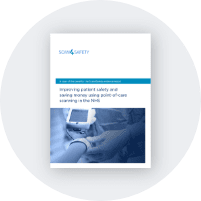

Complex systems require big thinking. And with big thinking often comes a host of lofty explanations around it. While embellished language will typically remain a feature of boardrooms, it’s never going to be the thing that gets the NHS to where we want it to be.
Thankfully, the Department of Health and Social Care have mandated the use of GS1 standards instead.
Originally rolled out in 2014 as part of Scan4Safety, GS1 standards have given the NHS one thing it never had before: a universal language. A language founded on the irrefutable truth of numbers as opposed to a language that all too often got lost in translation.
By using barcodes to assign unique identification for every patient, product, and place across multiple trusts, the NHS didn’t only end up speaking the same language at all levels – it improved everything from safety and efficiency, to patient experience. It gave them a way to turn things around.
Within the NHS, people have their own way of doing things. At Cambridge University Hospital, for instance, the staff had a habit of hoarding mobile medical equipment so they could easily access it when they needed it.
This resulted in hours of wasted time spent locating “missing” devices. But after identifying the problem, the solution was simple: to implement GS1’s Global Individual Asset Identifier system, using barcodes to track and trace equipment.
The new system generates a high-quality data trail that is tracked in real time, while being consistently updated at the exact point of care.
The system put everyone and everything on the same page, providing an accurate, standardised picture of where equipment is at all times. It’s this simplicity which underpins the attraction of GS1 as an agent of change within the NHS, and the reason it’s been so readily adopted for fluent reporting and auditing.
This was certainly the case when the Care Quality Commission visited the Barking, Havering and Redbridge University NHS Trust.
They knew drastic changes had to be made – and fast. With the simplicity of GS1 standards, they were able to quickly and easily install a new, scannable health records system. As well as improving the rate at which patient records were updated and logged, it generated a quality data trail that could be tracked in real time, while being consistently updated at the exact point of care.
The pattern here is clear. As a universal language, GS1 consistently offers a precise picture of what’s going on in any given trust, at any given time. Therefore, any changes in regular patterns or statistical outliers can be immediately flagged and addressed. As well as improving efficiency, this level of detection offers a level of security and safety.
The World Health Organisation, for instance, estimates that up to 10 per cent of all medicines globally are counterfeit.
As a result, the European Parliament introduced legislation requiring every pack of prescribed drugs to be barcoded so products can be checked and verified at all stages of the supply chain. That way, products cannot be reused or falsified.
Following on from this, Oxford University Hospitals NHS Foundation Trust ran a pilot scheme to identify where medicinal counterfeiting can take place. Using GS1 standards, they were able to model a series of best practices to help health services eradicate these potentially dangerous drugs from entering their systems.
Overall, GS1 isn’t only helping the NHS to transform itself, but turning our health service into a catalyst of change and global innovation.